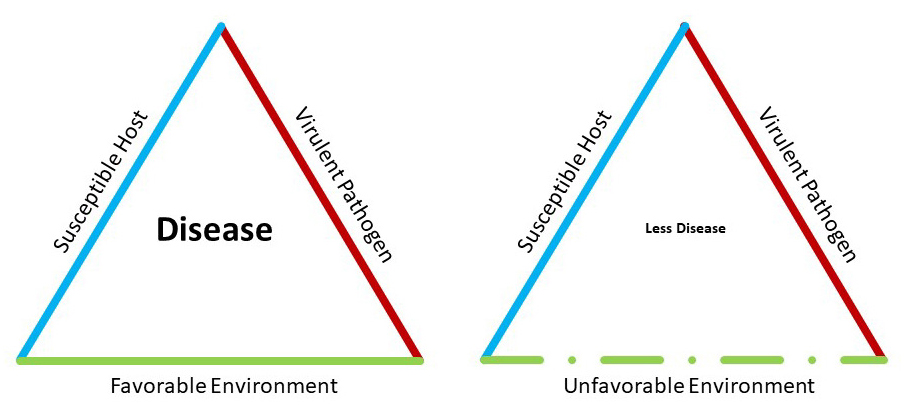‘Disease triangle’ indicates world is far from end of COVID-19 pandemic

Plants are no strangers to diseases and devastating outbreaks. Humans can learn a valuable lesson from them when it comes to the current COVID-19 pandemic, according to a Texas A&M professor.
While the urge is to return to our workplace and business once diagnosed COVID-19 cases peak, a Texas A&M AgriLife Research virologist and plant pathologist says one must only turn to the plant world to see how that would be a mistake.
“When we reach the peak, we are at best only halfway towards coming down from this mountain of disease,” said Karen-Beth Scholthof, a professor in the Department of Plant Pathology and Microbiology at Texas A&M University.
Scholthof concurs with Anthony Fauci, director of the National Institute of Allergy and Infectious Diseases, that social distancing should continue until there are essentially no new cases, no deaths.
Her reasoning is based on a long-standing concept from plant pathology, which she says describes the spread of any disease, explains why environmental measures matter, and sheds light on the similarities between plant and human diseases.
“All biology is connected. Now is the time to learn from other areas of science and the environment,” said Patrick J. Stover, vice chancellor of Texas A&M AgriLife, dean of the College of Agriculture and Life Sciences and director of AgriLife Research. “We may need to take extra time now, which we know will be difficult in the short-term, but life-saving for many in the long-term.
“The novel coronavirus is certainly revealing our vulnerabilities, from the food supply system to our social environments to the quality of life. We must learn from this experience, including prioritizing the development of cutting-edge technologies to protect from and prevent against COVID-19 and its far-reaching effects on our lives before we restart the vicious cycle once again, especially the most vulnerable.”
Disease outbreaks depend on the “disease triangle,” Scholthof said. This concept arose more than 60 years ago when George McNew, a plant pathologist at the Boyce Thompson Institute for Plant Research, diagrammed the fact that an epidemic arises from the interaction of three factors – a susceptible host, a virulent pathogen and a hospitable environment.
Scholthof said a simple form of McNew’s disease triangle is helpful to explain the key role of environment in the success of pathogens such as SARS-CoV-2, the virus that causes COVID-19.
Genetically identical plants are a “monoculture” and are especially vulnerable to emerging pathogens and disease. Today, plant pathologists break these cycles of disease by modifying or controlling either the host, the pathogen or the environment.
“We may breed crops that are resistant to the disease, plant them in a different way or at different times or use chemical treatments to protect the plants from harmful fungi, viruses, bacteria and insects,” Scholthof explained. “By changing the host with resistance genes, stopping the pathogen with chemicals, or altering the environment by planting earlier or later, for example, we can control an outbreak of a new disease or seasonal recurrence of a known pathogen.”
In the case of COVID-19, people are the susceptible hosts and SARS-COV-2, the virulent pathogen. The constant and close contact between people is the hospitable environment needed to keep this pandemic going strong. The novel coronavirus, having jumped from an animal host, has become extraordinarily successful at infecting humans.
“We do not have population-wide immunity to this virus,” Scholthof said. “Again, from Dr. Fauci, we ‘don’t make the timeline, the virus makes the timeline.’ Until drugs or vaccines are shown to control the virus and the disease, we can only do our part to disrupt an environment that is favorable to the novel coronavirus.”

